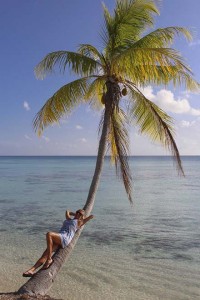 Welcome to our blog for the Plastic in the Pacific Crusade. If you missed the earlier editions please go to category file in the footer to go back and read them. They are listed under Plastic in the Pacific. Over the coming year we will be writing regularly of our adventures and what we are seeing. In this article we sail to Fakarava Atoll, Tuamotu’s
Welcome to our blog for the Plastic in the Pacific Crusade. If you missed the earlier editions please go to category file in the footer to go back and read them. They are listed under Plastic in the Pacific. Over the coming year we will be writing regularly of our adventures and what we are seeing. In this article we sail to Fakarava Atoll, Tuamotu’s
Having left Aratika Atoll early in the morning with a perfect beam reach sail forecast for the 40nm run down to Fakarava, the atmosphere onboard was awesome. It was a long time since we had a chance to go for a short sail of less than a day to get to a place in daylight hours. Behind Arataki Atoll the waters were flat and with a reef in the main and full headsail we were cranking along at 7’s easily. We cleared the southern end of the atoll and pointed a bit higher and would sail in perfect conditions all the way across the gap, passing the atolls of Toau and Kauehi which are both reported to be beautiful, however our requirement was to get Annika’s ear fixed so we can get back to diving.
We approached Fakarava’s northern pass and it is very wide and could be transited at any tide, in or out. It is very deep as well and after transiting on an outgoing tide with just 1-2 knots against us, we headed to the north-eastern end of the island to the township of Rotoava. It is a short 5nm across the atoll and the color of the waters seemed to be even better than Aratika. We would later find out that this is due to a lot more silt floating around. Over at Rotoava we were told the doctor’s office was on the same street as the dive center so when we saw the dive center we anchored out the front of there. We didn’t realise that of the 7 white fishing buoys out the front, 5 were allocated moorings for visitors, the other two belonging to the dive shop. Basically the southern 1 and 4 northern ones can be used by any cruising yachtie, usually without charge.
After lunch we went ashore and found out that the street mentioned to us was the same street that runs around the entire NE end of the atoll. The doctor’s office was a short 1km walk up the road. We passed a couple of supermarkets, closed for lunch, and then past the school and found the medical center. We were asked to wait and after a short while we entered and were met by an African nurse who was relieving for the main doctor. It was quite an amusing session as he inspected Annika’s ear and then said he had the solution and handed her a packet of ear drops for divers ears. Then he asked if we wanted anything else for the boat in the way of prescription drugs, he had everything he said. He didn’t take no for an answer easily. The free consultation part was a real surprise and the free drugs was even better. We didn’t need anything as we have a fully stocked first aid kit on board.
Having left the doctors and with a diagnosis of a week out of the water, it meant no diving which was a real shame as the two passes in Fakarava have very good reputations for good shark dives with lots of fish. The northern pass is quite wide and we are told it is best to go with one of the dive centers as it is a drift dive and the surface gets pretty rough for a dinghy. We went to the two supermarkets and topped up our supplies. They had a good supply of most things but again, very little fresh food. We were told that breadfruit is not sold as it grows on trees in abundance and to help ourselves to any we see in the streets.
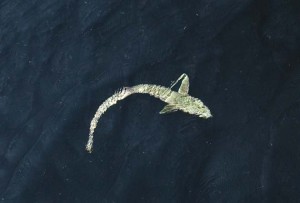 We then visited the Top Dive diving shop and spoke with one of the instructors and watched a video of the north pass. It looked spectacular but we would have to pass for now. Hopefully we would get back sometime in the near future. We asked the lady behind the desk about the local school because if we weren’t diving we would try and get into the school. She gave us the name of the head mistress Chantal and said to meet her at 0700 the next morning. We spent the afternoon on the boat relaxing and cleaning the hull. As I jumped in the water I noticed about 20 remora’s swimming around under the boat. Several were attached to the hull using their unique suction cap heads. These guys would hang with us the entire time we were in Fakarava and halfway to Tahiti. If you don’t know, a remora is a fish that will attach itself to any larger creature and feeds as a scavenger from the parent it is attached to. They are funny looking fish with mouths on top of their heads along with the suction cap.
We then visited the Top Dive diving shop and spoke with one of the instructors and watched a video of the north pass. It looked spectacular but we would have to pass for now. Hopefully we would get back sometime in the near future. We asked the lady behind the desk about the local school because if we weren’t diving we would try and get into the school. She gave us the name of the head mistress Chantal and said to meet her at 0700 the next morning. We spent the afternoon on the boat relaxing and cleaning the hull. As I jumped in the water I noticed about 20 remora’s swimming around under the boat. Several were attached to the hull using their unique suction cap heads. These guys would hang with us the entire time we were in Fakarava and halfway to Tahiti. If you don’t know, a remora is a fish that will attach itself to any larger creature and feeds as a scavenger from the parent it is attached to. They are funny looking fish with mouths on top of their heads along with the suction cap.
 The following morning we went to the school and waited for Chantal to arrive. Now sometimes I feel the ocean rewards us for our efforts in educating the youth of the issue of plastics in the ocean, however I never expected the reward of this particular day. It was the last day of school before a 2 week holiday and it was ‘pancake day’. Every student brought pancakes which I got a few of. Unfortunately Annika couldn’t partake so I ate hers too. Chantal was actually teaching a class this day so she invited us straight into her class. She was very excited to have us there and wanted to show us everything that the school does with regards to environmental awareness, which was quite excellent.
The following morning we went to the school and waited for Chantal to arrive. Now sometimes I feel the ocean rewards us for our efforts in educating the youth of the issue of plastics in the ocean, however I never expected the reward of this particular day. It was the last day of school before a 2 week holiday and it was ‘pancake day’. Every student brought pancakes which I got a few of. Unfortunately Annika couldn’t partake so I ate hers too. Chantal was actually teaching a class this day so she invited us straight into her class. She was very excited to have us there and wanted to show us everything that the school does with regards to environmental awareness, which was quite excellent.
She showed us water bottles that had been cut in half and decorated as Christmas tree decorations. They had a recycling center where they stored all sorts of things like bags, cans, egg cartons etc to later use for art and craft. They used old yoghurt dishes for pencil holders, old fruit bottles to hold towels to wash the students individual chalk boards and they used other containers to grow seedlings which would later be given to parents. So these students already had a little awareness on the 3R’s that we teach, Reduce, Reuse and Recycle.
As each student entered the classroom, Chantal told them to say hello to us in English. It was really a nice touch. Then at the start of the class she introduces us and we present our lesson. This time we presented it using our French Lesson on the projector, but spoke in English to the students to add to the program. Chantal translated what they didn’t understand and they were all very enthusiastic. Several students started giving the big thumbs down as the images of dolphins and turtles with plastic with them came up. And then the highlight of the lesson came as the students were told to say ‘I can do it’ in English. Then every time a mission came up for the students to complete, they would say ‘I can do it.’ It was fantastic. After the lesson we went over to another room where we were shown a program the school runs where they go snorkeling in certain locations and list the type and number of fish and reef to see how everything is being effected. They would go back several times throughout the year and make their observations. Great little program to create awareness.
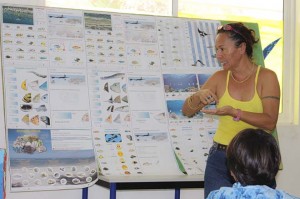 Once again we left the school enthused that the future generations are going to work harder on ocean preservation than the current generation. We really have a lot to answer for as we have become a very lazy generation where we consistently use plastic as a convenience item. Before our time they didn’t have plastic and coped just fine. One of the good things in these islands is the reuse of glass bottles. Beers and soft drinks come in glass bottles and whilst there is still a plastic cap on the 1 liter glass soft drink bottles, this is far less plastic than the common plastic bottles that companies like Coca-Cola and Pepsi are throwing at us in huge numbers. With a 60 cent fee on each bottle, you are going to return them and sure enough, you don’t see too many around in the streets. However there is no deposit on the plastic containers and they are found frequently all over the islands. If the government just banned the plastic bottles, it would be so much better as these places burn rubbish rather than recycle so all the plastic is burnt, putting up toxic gasses into our atmosphere that will continue to break down the Ozone layer that keeps us safe from the suns rays. Alternatively they could introduce the same 60 cent deposit scheme on plastic bottles and have them returned for proper recycling. Either way something needs to be done.
Once again we left the school enthused that the future generations are going to work harder on ocean preservation than the current generation. We really have a lot to answer for as we have become a very lazy generation where we consistently use plastic as a convenience item. Before our time they didn’t have plastic and coped just fine. One of the good things in these islands is the reuse of glass bottles. Beers and soft drinks come in glass bottles and whilst there is still a plastic cap on the 1 liter glass soft drink bottles, this is far less plastic than the common plastic bottles that companies like Coca-Cola and Pepsi are throwing at us in huge numbers. With a 60 cent fee on each bottle, you are going to return them and sure enough, you don’t see too many around in the streets. However there is no deposit on the plastic containers and they are found frequently all over the islands. If the government just banned the plastic bottles, it would be so much better as these places burn rubbish rather than recycle so all the plastic is burnt, putting up toxic gasses into our atmosphere that will continue to break down the Ozone layer that keeps us safe from the suns rays. Alternatively they could introduce the same 60 cent deposit scheme on plastic bottles and have them returned for proper recycling. Either way something needs to be done.
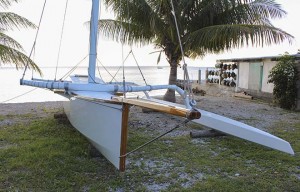 After the school visit we went for a walk through town and back to the boat. Next to where we put the dinghy was a beautifully crafted local sailing vessel. It looked like a trimaran with a missing pontoon on one side. The decks were beautifully done as Annika’s photos will show you. We then boarded Susky and moved south a little to get away from town and get closer to the Pearl Farm. After lunch we went for a walk and found the pearl farm closed which was a shame as here you can go the lottery and pay to dive for your own pearl. You get what you get, sometimes you can win with a $100 plus pearl, other times you will get something ordinary.
After the school visit we went for a walk through town and back to the boat. Next to where we put the dinghy was a beautifully crafted local sailing vessel. It looked like a trimaran with a missing pontoon on one side. The decks were beautifully done as Annika’s photos will show you. We then boarded Susky and moved south a little to get away from town and get closer to the Pearl Farm. After lunch we went for a walk and found the pearl farm closed which was a shame as here you can go the lottery and pay to dive for your own pearl. You get what you get, sometimes you can win with a $100 plus pearl, other times you will get something ordinary.
The following day we would sail slowly down the coast to get to about the half way mark. It was a 12nm sail and we just sailed with the headsail taking nearly 4 hours to complete the trip. We found an anchorage which was a little bit special to say the least. Tucked in behind a reef which had azure waters surrounding it and a white beach with a few palms was just heaven. I have to admit that we would like to know who writes the word ‘Palm’ on the charts in these places. To say there is a palm here and a palm there is so silly because they are everywhere. You can’t navigate by the term, turn left at the palm tree!!!!! We went for a snorkel and explore and the reef was alive with lots of little fish and hard corals. It really was like an aquarium down there.
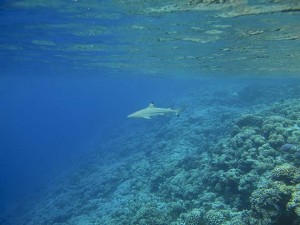 That night we checked the weather and realised the northerlies were coming a little earlier and a little stronger. Annika’s ear was not really recovering so we had decided that we would sail to the South Pass to snorkel there and then get to Tahiti to see a ‘real’ doctor as soon as we could. So after a splendid night chilling on the yacht in our paradise location, we headed the next morning to the south end. It was a bit rough and we tried to tuck behind a reef but it was still quite bouncy. We just wanted to snorkel on the low tide and then we would get through the pass and head towards Tahiti. After lunch we jumped in the tender and drove over to the pass and talked to a local charter yacht about the snorkeling/diving. He told us the time to snorkel was over the next hour and told us about the swimming pool over near the huts. All the time we are talking to him, 5-6 blacktip reef sharks are swimming around the back of the boat. With the shallow anchorage he was in and being able to see the reef below him, it was pretty cool. Unfortunately he was on a private mooring so we couldn’t get in the same spot without destroying a lot of coral.
That night we checked the weather and realised the northerlies were coming a little earlier and a little stronger. Annika’s ear was not really recovering so we had decided that we would sail to the South Pass to snorkel there and then get to Tahiti to see a ‘real’ doctor as soon as we could. So after a splendid night chilling on the yacht in our paradise location, we headed the next morning to the south end. It was a bit rough and we tried to tuck behind a reef but it was still quite bouncy. We just wanted to snorkel on the low tide and then we would get through the pass and head towards Tahiti. After lunch we jumped in the tender and drove over to the pass and talked to a local charter yacht about the snorkeling/diving. He told us the time to snorkel was over the next hour and told us about the swimming pool over near the huts. All the time we are talking to him, 5-6 blacktip reef sharks are swimming around the back of the boat. With the shallow anchorage he was in and being able to see the reef below him, it was pretty cool. Unfortunately he was on a private mooring so we couldn’t get in the same spot without destroying a lot of coral.
We motored over to the swimming pool and there in chest deep water you could see lots of sharks swimming around. To find the swimming pool you go to the southern end of all the balconies and find 3 pieces of steel reinforcement sticking up out of the water. You go in here. You can see the reef tail away towards the middle. We visited the local church that survived the cyclone that knocked out everything else when this location used to be the capital of the Tuamotu’s. The pearl shell alter is spectacular and the whole church is so nicely kept. Not bad for a population of around 50 people.
Back in the water and the sharks were everywhere but my GoPro had a flat battery so we shot back to the boat, Annika grabbed her camera and back we went. This time we went out to a small buoy out the pass and drift snorkeled in towards the swimming pool. Being an hour after low tide, the water was crystal clear with an easy 40-50m visibility. Hard corals lined the wall and it was easy to tow the dinghy behind us. You could do this diving too, it is quite an easy dive/snorkel in the right conditions. Sharks were everywhere and as we entered the swimming pool again, a huge Mauri Wrasse greeted us along with the numerous sharks. I wanted to stay but this time Annika’s battery went flat and we needed to get out the pass before dark so we reluctantly got out and headed back to the yacht.
 We quickly packed everything away and retrieved our anchor and made our way out the pass. It is quite easy and we always head 2.5m under our keel in the shallow spot. Once out, we set sail and headed off into the sunset, although it was overcast, a sign of things to come. 3 remora’s were still clinging to the hull. You could see their tails hanging out the back. We really did not do anywhere near enough exploring of this atoll and we hope that the weather allows us back when we get some friends onboard later in March. Otherwise we will have to get back some other time. The Tuamotu’s is Paradise. It lived up to my expectations and we will be back, that’s a promise.
We quickly packed everything away and retrieved our anchor and made our way out the pass. It is quite easy and we always head 2.5m under our keel in the shallow spot. Once out, we set sail and headed off into the sunset, although it was overcast, a sign of things to come. 3 remora’s were still clinging to the hull. You could see their tails hanging out the back. We really did not do anywhere near enough exploring of this atoll and we hope that the weather allows us back when we get some friends onboard later in March. Otherwise we will have to get back some other time. The Tuamotu’s is Paradise. It lived up to my expectations and we will be back, that’s a promise.
In our next edition we sail to Tahiti
Ocean Crusaders are out to change the way people treat our oceans. Our online education program is free to download at www.OceanCrusaders.org/education where children can learn of the issues our oceans are facing and how they can make a difference. The Plastic in the Pacific Crusade is about educating the South Pacific Islands, finding out what is happening in these islands and updating our programs. You can join us in the Pacific and see for yourself what we do.
Ocean Crusaders Plastic in the Pacific Crusade is proudly supported by: Cressi Dive Gear, Gill Marine, Keen Footwear Australia, Barz Optics Sunglasses, Maxsea Navigation Software, Digital Diver Cairns, LED Dive Lights Australia, Boat Names Australia, Predictwind Weather & Sail-world.com
[cincopa A4FABSdhrnhY]
SIGN UP FOR OUR BLOGS